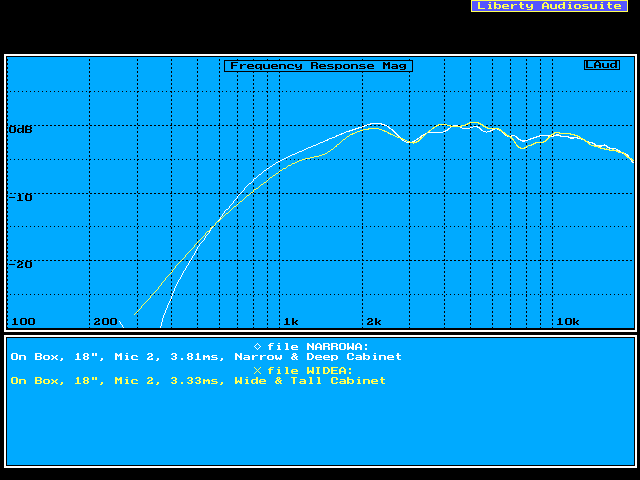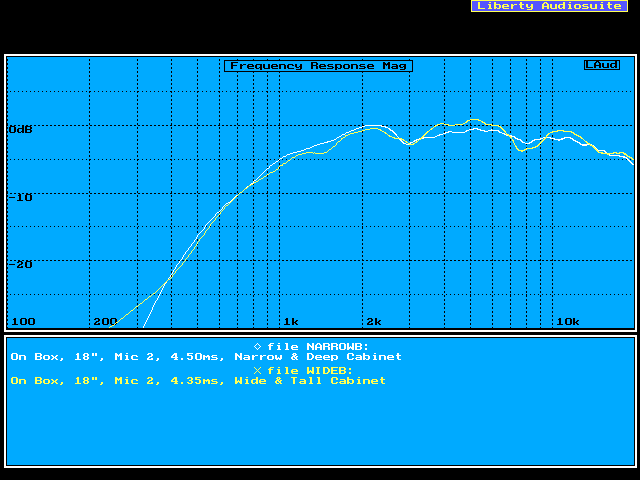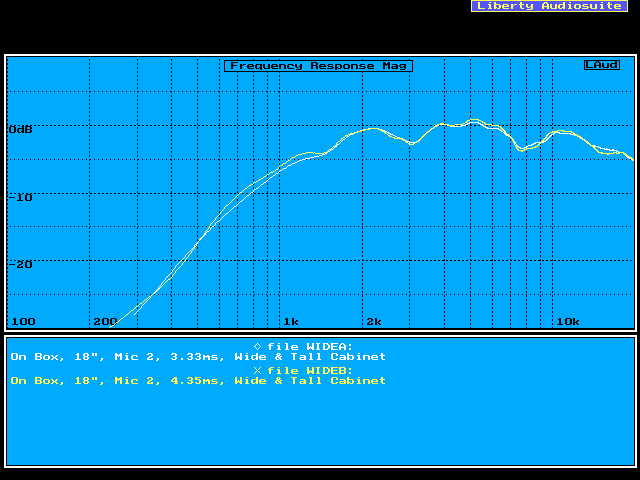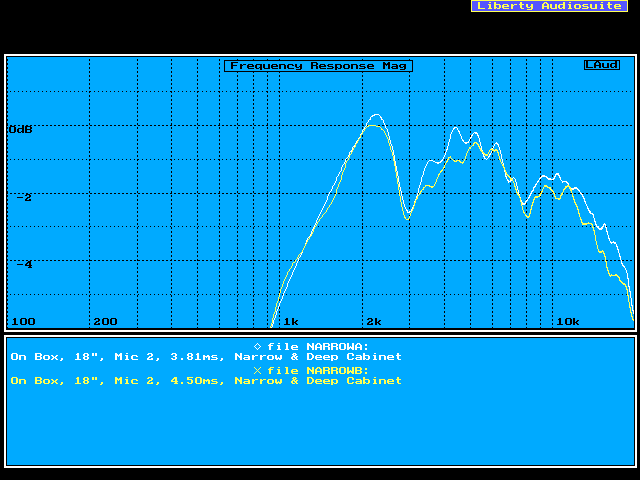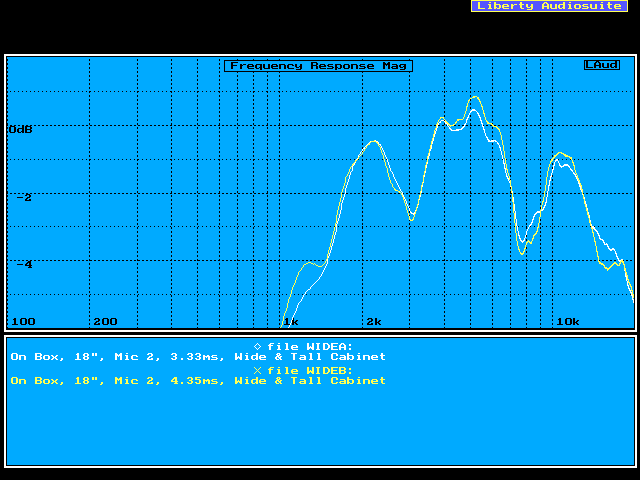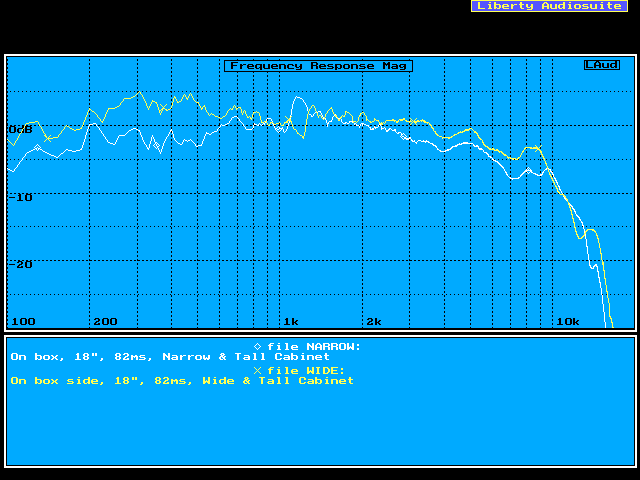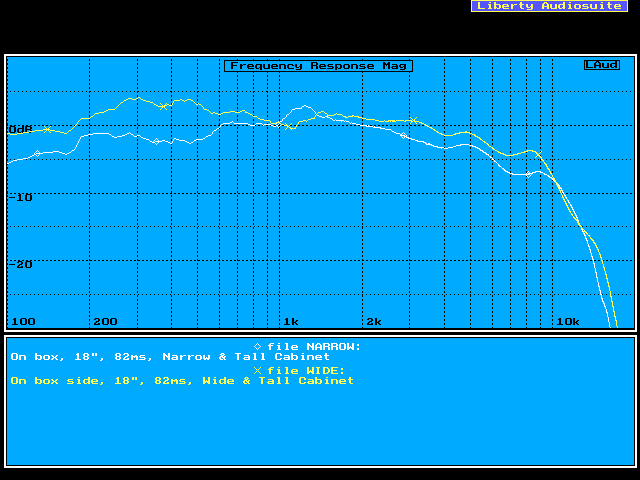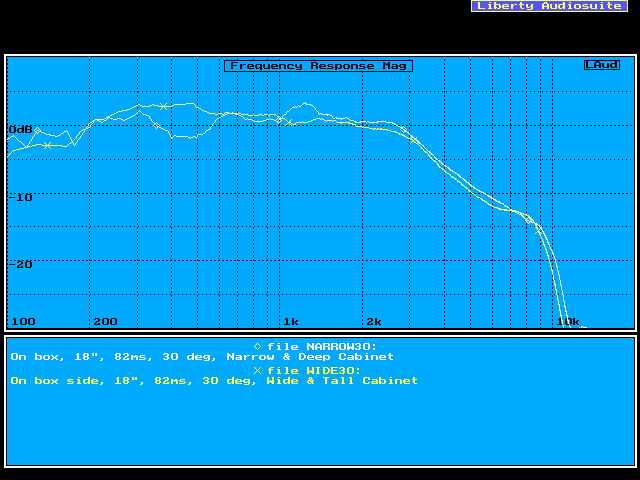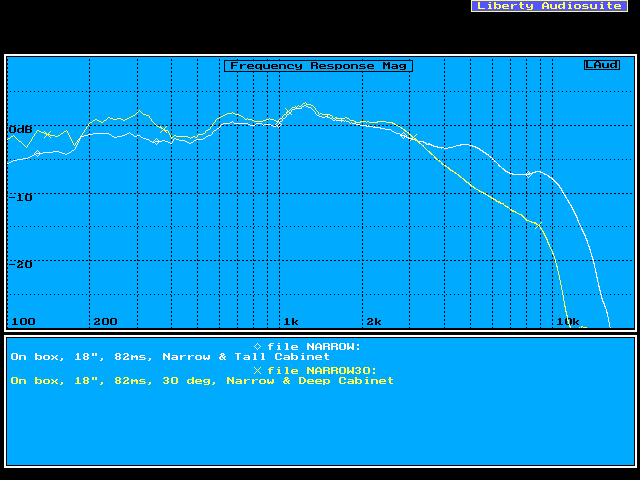Prototype #1 is a rather “typical” enclosure. The front baffle is just wide enough, and tall enough for the drivers and a (future) bass-reflex port. The remainder of the volume is depth. Anyone can, and it seems everyone does, make a cabinet that simple. But what about a cabinet that is just the opposite? Tall, wide, and just deep enough to form a golden-mean transmission line.
Prototype #2 Description
The cross-sectional dimensions of the golden-mean transmission line are 2-3/4″ deep by 4-1/2″ wide. This width fits perfectly with the Vifa mid-range’s mounting hole diameter. Add a 1-1/2″ double-thickness front and a single-thickness 3/4″ back to the depth generates a total cabinet depth of 5″. But what dimensions for the cabinet front? Well, nothing is wrong with a 1:4:9 ratio, so why not 20″x45″! I had yet to discover medium sized pieces of MDF board at Home Depot (read: pieces of MDF that fit into the trunk of a 3 series BMW). So, to get a 20″ wide face, I glued together two 12″x48″ deep shelf boards. Another shelf board section was glued to the back to get a double baffle where the drivers mount. You can see the sanding marks where the glue edge was smoothed in the front. A few passes with the router set up a 1/4″ deep labyrinth for the walls that would define the rear chambers for each mid-range. I wasn’t working towards testing a transmission line yet so I made these chambers 4 liters, stuffed with some spare wool, and sealed.
| Front | Inside | Back |
|---|---|---|
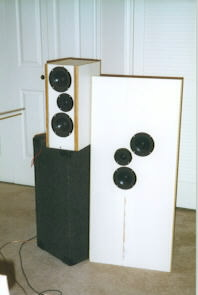 |
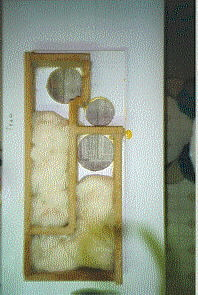 |
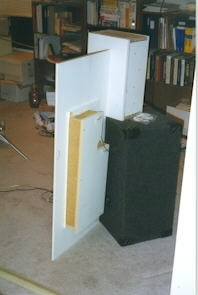 |
Narrow & Tall vs. Wide & Deep Cabinet
Having two cabinets with opposite shapes begs the question: what will the differences in driver responses be? My expectation was to see much less ripple in the responses measured on the wide and tall baffle, especially in the upper mid-range. The differences I found, however, were not that significant.
General Testing Conditions
As usual, testing was done in a section of my living room that I have freed up of clutter and furniture. To get a clean measurement, the microphone distance was 18″. As shown in the front picture above, the measurement position is just in front of my washer/dryer closet. For some of the tests Speaker II is used as a stand to raise the driver level and thereby increase the measurement window length.
I also (finally) took the time to learn how to save response data in LAud™ and then display multiple measurement records on the same plot. Thus, most graphs are comparisons of some sort.
Tweeter Tests
The acoustic diffraction induced response anomylies I was expecting didn’t show up at all!
At this point I was rather perplexed. The first thought that came to mind was that the tweeters in each prototype cabinet are different. Thus, I swapped the tweeters between the narrow and wide cabinets. I had to be sure that what I was measuring was not a variation in tweeter units. Take a look at tweeter unit “A” measured in each prototype cabinet:
There is not a whole lot of difference! I was expecting much more of a delta between these two measurements. The diffraction theory I had been reading strongly suggested
- The response dips and peaks would be at different frequencies, and
- The magnitude of the dips and peaks would be at least 3 dB less on the wide cabinet.
If anything, it appears that the wide & tall cabinet has more pronounced dips in the response. Compare this to tweeter unit “B”:
The trends are the same. Hmmmmm… next question… how well matched are the two Vifa tweeter samples? Tweeters A and B on the wide & tall baffle:
As you can see, the match is quite good. Keep in mind that these units are not a matched pair! (They are probably from the same lot.) Now expand the graph’s y-scaling to see just how closely the units match (both baffles shown):
I would say the quality of matching is about +/- 0.5 dB. Both Morel and Dynaudio charge $$$ for this, but with Vifa you get it for free!
Mid-range Tests
Testing the mid-ranges proved more difficult than the tweeters.
- I couldn’t test the top and bottom mid-ranges independently and do a comparison between the wide & tall and narrow & deep baffles. Why? The mid-ranges in prototype #1 share a common enclosure while those of prototype #2 each have separate enclosures. That is, if only one mid-range is connected in prototype #1, the other mid-range acts as a passive radiator. That changes the bass response, and possibly affects hi-frequency measurements too.
- Guaging baffle diffraction correctly for these tests requires measurements below 100 Hz. The long time measurement this requires will include a strong floor reflection, a.k.a., floor-bounce. Floor-bounce commonly manafests itself as a dip in the mid-bass region somewhere between 200 – 400 Hz. This dip is sometimes also accompanied by a peak of 3 – 6 dB at about double the dip’s frequency.
The first issue required connecting the mid-ranges together and carefully positioning the microphone the same distance from each mid-range dust cap. Speaker II was used as a stand for prototype #1, then turned on its side as a stand to raise prototype #2’s driver heights. That I figured would minimize the floor reflection as much as possible. In addition, the mid-range plots were all smoothed in order to reduce “reflection noise.”
Here is the graph comparing the narrow & deep cabinet with the wide & tall cabinet. This plot has 1/12th octave smoothing:
Most of the small dips and peaks are found in both measurements, especially in the high frequencies. The primary difference is in the lower mid-bass. There, the large baffle has substantially more response. The next plot is smoothed with a 1/3rd octave filter to help to illuminate the general trends in the response curve:
The general impression is that the mid-range drivers in the wide & tall baffle are more efficient. This is as it should be; the mid-bass region should be lifted up because the diffraction frequency is lowered from about 700 Hz to 150 Hz. It also does appear that this Vifa mid-range’s response has been designed to be flat on a “typical,” narrow baffle.
30 degree Off-axis Mid-range Tests
Having established that the mid-bass is lifted by a wider baffle, the next step was examining effects of a wider baffle on off-axis response.
It appears that the hi-frequency response roll-offs are the same for the wide & tall and narrow & deep enclosures. Question answered. The final two graphs compare the on- and off-axis response of the prototype cabinets to themselves.
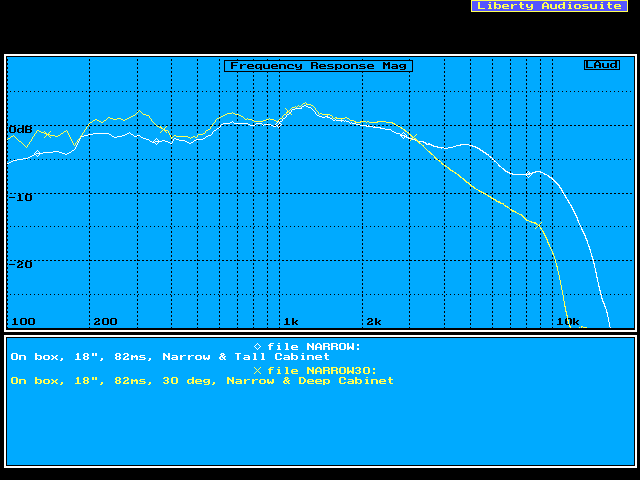
The measurements don’t compare too well, but the on- and off-axis responses separate starting at 3 kHz for the narrow enclosure.
The wide enclosure measurements are better behaved. The separation of the on- and off-axis responses is again 3 kHz. However, the 2-3 kHz range has a little more seperation, but I doubt it is significant.
Conclusions
Prototype #2’s test results really surprised me. Now its time to put it all into perspective.
The diffraction effects I was expecting to measure did not materialize. I have a few candidate reasons as to why:
- The measurement distance of 18″ was “too close” in the sense of near-field vs. far-field.
- The 1/2″ radius on the edges was sufficient to eliminate the diffraction, especially at the high frequencies.
- Recessing of the driver’s isn’t taken into account by diffraction theory. (The soft dome of the Vifa tweeter is recessed below the face plate.)
Copyright © 1999 John Lipp
